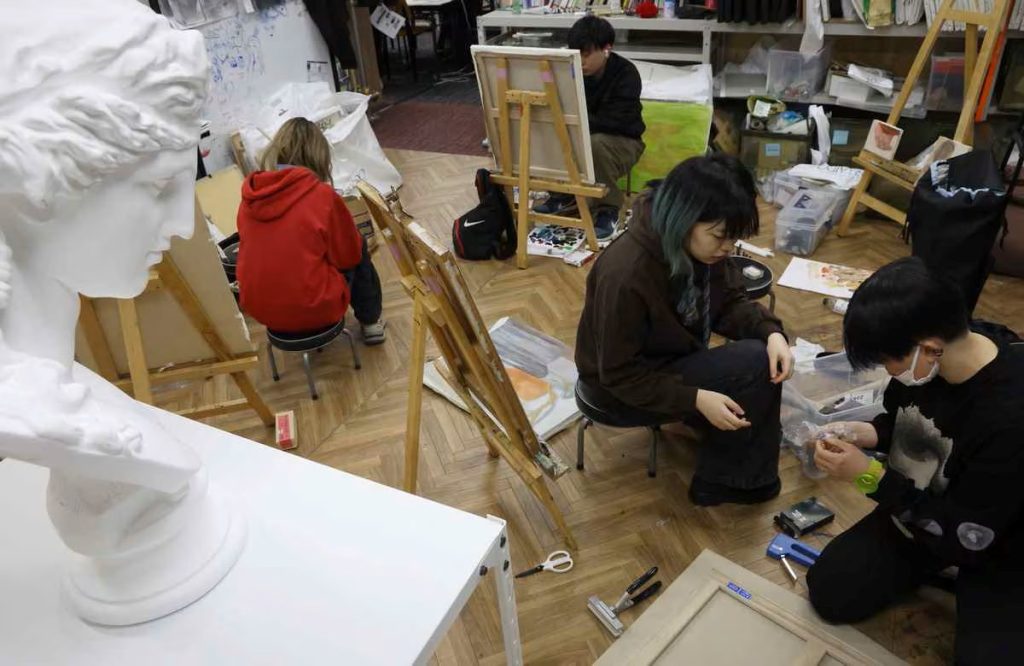
Students work on projects in the art course at Coach Academy, a prep school for Chinese students. The program, launched in 2015, continues to grow. February 28, Shinjuku, Tokyo. (©Sankei by Katsuyuki Seki)
このページを 日本語 で読む
Roughly 70% of foreign students at Japan's art and design universities are from China, according to school statistics. Observers say the trend may be tied to Japan's permanent residency system, with many seeing careers in "Cool Japan" industries — like games and anime — as a fast track to long-term residency.
Inspired by Pokémon and Monster Hunter
One is Zhou Shigang, a 31-year-old student from China. He is set to graduate from Kyoto University of the Arts in March. From April, he'll start work at a game company in Kyoto, where he'll begin with game design modeling, transforming 2D artwork into 3D. "Eventually, I want to develop a game that reflects my own worldview," he says.

Zhou's interest in Japanese game design began in high school in China, where he admired titles like Pokémon and Monster Hunter.
To prepare, he enrolled in the art prep course at Coach Academy, to learn basics like drawing. The academy is a Japanese prep school for Chinese students. He also studied at a language school to improve his Japanese.
Zhou has passed the N1 level of the Japanese-Language Proficiency Test, the most advanced level. There was no trouble communicating during job hunting, he says. Currently, he is still on a student visa. However, he plans to switch to an "Engineer/Specialist in Humanities/International Services" (gijinkoku) work visa after joining the company.
He also has a Japanese partner and hopes to continue living in Japan, with the goal of obtaining permanent residency.
From Work Visa to Highly Skilled Status to Permanent Residency
In recent years, Japan has clarified its visa policy for international students like Zhou who major in fields tied to "Cool Japan" industries. Those include gaming, anime, fashion design, and food.
In 2017, the government announced that graduates aiming to work in Japan would generally qualify for the gijinkoku work visa. Even if a company provides six months of training post-hire, applicants may still be approved — so long as they eventually take on substantive work. This effectively lowered the barrier to securing a work visa.
At the same time, requirements were eased for the "Highly Skilled Foreign Professional" status, which gijinkoku visa holders may apply for. The minimum residence period in Japan for permanent residency eligibility was shortened from five years to just one to three. This is a major shift, considering that foreign nationals are typically required to live in Japan for at least ten years before applying for permanent residency.
Highly skilled status is determined through a points-based system that evaluates education, work experience, and Japanese language skills. For international students who graduate from a Japanese university and start working, the points threshold is relatively easy to meet.
These policy changes have made jobs in design-related fields widely seen as a shortcut to permanent residency. It is an appeal that seems to be driving the surge in Chinese enrollment at Japan's art and design universities.
Brokers May Be Guiding Students Through the Process
As of May 2024, data from major art universities (excluding correspondence courses) show that Chinese students account for roughly 70% of all international students. At Kyoto Seika University, 909 of 1,273 international students were Chinese. The figure was 692 out of 872 at Kyoto University of the Arts. At Musashino Art University, 462 out of 703 were Chinese. Meanwhile, at Tokyo University of the Arts, 245 out of 352 were from Japan's giant neighbor.

Both the number and proportion of Chinese students are rising steadily. Kyoto University of the Arts, for example, saw its Chinese student population soar from 60 in 2015 to 692 in 2024. That represents an elevenfold increase.
A Japanese lawyer familiar with the highly skilled visa system commented on the trend:
"It's hard to believe that Chinese students fully understand the entire process on their own — from securing a job and obtaining a gijinkoku visa, to moving on to a highly skilled visa and ultimately applying for permanent residency," he said. "Brokers, acting as intermediaries in both China and Japan, are undoubtedly involved. They advise students on study and employment opportunities."
Highly Skilled Foreign Professional Program
Introduced in 2012, the Points-Based Preferential Immigration Treatment program aims to promote the acceptance of foreign nationals with specialized skills. Applicants are categorized into three fields based on their field of activity: Advanced Academic Research, Advanced Specialized/Technical, and Advanced Business Management.
Each category is evaluated using a point-based system. This considers factors such as education, work experience, Japanese language proficiency, and annual income. For example, in the Advanced Specialized/Technical category, a doctoral degree earns 30 points, more than 10 years of work experience adds 20 points, and research achievements contribute 15 points. Younger applicants also receive additional points for age.
Those who score 70 points or more are granted Highly Skilled Professional status and may apply for permanent residency after three years in Japan. Applicants with 80 points or more can apply after just one year.
In addition to relaxed permanent residency requirements, highly skilled professionals enjoy various other benefits. These include extended periods of stay and, depending on income, the ability to bring parents or domestic workers to Japan.
According to the Immigration Services Agency, approximately 24,000 highly skilled professionals were living in Japan as of the end of 2023. This is about 30 times more than a decade earlier. By nationality, Chinese nationals made up the largest share, accounting for around 16,000 individuals, or roughly 70% of the total.
RELATED:
- Foreign Population in Tokyo Soars as Chinese Buyers Seek Condos
- Saitama Prefecture Sees Surging Demand for Language Support Among Non-Japanese Students
- Forced Repatriation of Overseas Chinese Focus of New Report
Author: Shoki Nakamura
このページを 日本語 で読む







